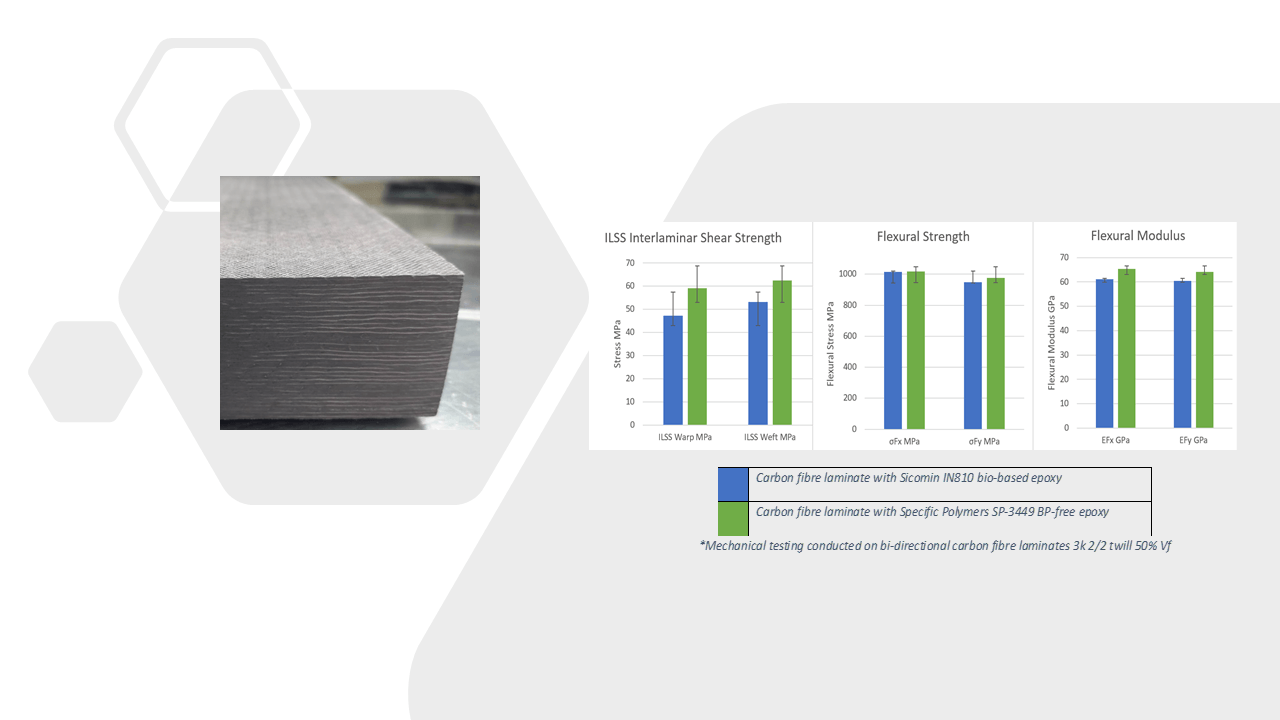News & Events > Project developments > Advancing Carbon Fibre Composites: Bio-Based, Bisphenol-Free Epoxy for a Sustainable Future

Advancing Carbon Fibre Composites: Bio-Based, Bisphenol-Free Epoxy for a Sustainable Future
19.02.25
| Introduction Juno Composites Ireland, in collaboration with Specific Polymers France under the Horizon 2020 VIBES project, has successfully developed a thick monolithic quasi-isotropic carbon fibre plate using Specific Polymers’ bisphenol-free (BP-free) bio-based epoxy resin. As part of this development, Juno benchmarked Specific Polymers’ epoxy resin against InfuGreen from Sicomin France, a leading marine epoxy resin system. The results demonstrated 25% improvement in interlaminar shear strength (ILSS) performance and 7.4% increase in flexural modulus, highlighting the enhanced mechanical properties of Specific Polymers’ innovative BP-free epoxy. These improvements are attributed to several key factors: • Superior Fibre-Matrix Interaction: Specific Polymers’ chemistry has a higher initial epoxy content leading to stronger interfacial bonding with the carbon fibres, enhancing load transfer and reducing micro-cracking. • Enhanced Stiffness of the Matrix: the novel BPA epoxy possess higher crosslinking density that could explain the enhanced stiffness and ILSS Interestingly, the composite flexural strength between two resin systems remained similar. This suggests that while the Specific Polymer’s novel BPA free epoxy improved the interfacial adhesion and stiffness, the ultimate fibre-dominated failure mechanisms were not significantly affected, as the reinforcement itself was identical. Juno Composites’ Expertise in Manufacturing A key factor in achieving the exceptional performance of these plates is not just the advanced resin system but also Juno Composites’ manufacturing expertise. Juno’s ISO 9001-2015 accredited production facility with their proprietary βetaFab process ensures: • High Fibre Volume Fraction (Vf): Optimised for superior mechanical performance. • Minimal Voids: Precision control of the infusion and curing process results in a high-quality laminate with near-zero defects. • Consistent Quality: Rigorous quality assurance and testing ensure repeatability and reliability in every batch. • Advanced Processing Techniques: Tailored manufacturing strategies maximise the potential of the carbon fibre-BPA free epoxy combination. Collaborative Demonstrator: Advancing Composite Innovation Juno Composites and Specific Polymers have jointly developed a thick, monolithic quasi-isotropic carbon fibre plate using Specific Polymers’ BP-free bio-based epoxy resin as part of the VIBES project. This demonstrator highlights the combined expertise of Juno Composites in advanced composite manufacturing and Specific Polymers in innovative ‘Green’ resin chemistry, pushing the boundaries of high-performance, sustainable composite materials. Key Features of Quasi-Isotropic Carbon Fibre Plates • Optimised Mechanical Performance: Multi-directional fibre orientation (0°, 90°, ±45°) ensures uniform strength and stiffness. • Lightweight & High Strength: Superior to traditional metals, reducing weight while maintaining robustness. • Sustainability with Bio-Based Resin: Specific Polymers’ BP-free bio-based epoxy reduces environmental impact and maintains high durability. • Heat & Chemical Resistance: Ideal for demanding environments requiring long-term performance. Real-World Applications • Aerospace: Structural panels, wing spars, and interior components. • Automotive & Motorsport: Chassis elements and crash protection structures. • Industrial & Robotics: Precision tooling, lightweight machine frames. • Marine: High-strength hull components and bulkheads. Conclusion The successful development of bisphenol-free bio-based epoxy composite materials marks a significant advancement in sustainable high-performance engineering. By integrating Specific Polymers’ bisphenol-free epoxy with Juno Composites’ advanced manufacturing expertise, the resulting quasi-isotropic carbon fibre plates demonstrate superior mechanical properties while reducing environmental impact. This breakthrough has direct applications in drones and marine engineering, where lightweight, high-strength, and environmentally responsible materials are essential. The improved interlaminar shear strength and flexural modulus enhance structural integrity, making these composites ideal for unmanned aerial vehicles (UAVs), lightweight marine structures, and other demanding applications requiring durability and sustainability. Juno Composites and Specific Polymers, through the Horizon 2020 VIBES project, continue to push the boundaries of green composite materials, setting a new standard for next-generation aerospace, marine, and high-performance industrial applications. For more information on the Horizon 2020 VIBES project and its innovations in sustainable composite materials, visit VIBES Project. For more details, visit Juno Composites or contact us at info@junocomposites.com to discuss your application needs. |